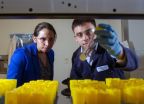(Press-News.org) Scientists seeking a more efficient way of protecting the heart of Africa's wildlife—the Greater Virunga Landscape—have developed a method to make the most of limited enforcement resources, according to a new study by the Wildlife Conservation Society, the University of Queensland, Imperial College London, and the Uganda Wildlife Authority.
By channeling data on wildlife sightings and park guard patrolling routes into spatial planning software, conservationists have devised a cost-effective method for maximizing the deterrence effect of patrolling to protect Africa's threatened wildlife from poaching and other illegal activities.
The enforcement-targeting method is described in a study appearing in the current edition of the Journal of Applied Ecology and is freely available online.
"The Greater Virunga Landscape contains many natural wonders, but resources for enforcement across this huge area are limited," said Dr. Andrew Plumptre, lead author of the study and Director of the Wildlife Conservation Society's Albertine Rift Program. "Our spatial analysis allows us to identify weaknesses in current efforts, which we can use to redirect enforcement and increase efficiency and conservation impact."
Stretching through Uganda, Rwanda, and the Democratic Republic of Congo, the Greater Virunga Landscape is one of the most biodiverse places on Earth and is home to all of the world's mountain gorilla populations. Much of the region's mountains, forests, lakes, and savannas are contained in a total of 13 protected areas covering 13,800 square kilometers. The region also contains populations of chimpanzees, elephants, hippopotamus, lions, and many other species.
The authors of the study conducted their analysis by first determining the distribution of key species and habitats. Data on the distribution of threats was then added, followed by estimates of current patrol effort and the cost of patrolling parks, protected areas, and other wildlife-rich regions effectively. All data layers were then used to conduct a spatial prioritization to minimize the cost of patrols and maximize the protection of wildlife species.
What the authors found was that only 22 percent of the Greater Virunga Landscape is being effectively patrolled at present. "The key problem is trying to ascertain where to send patrols to make them effective," said Dr. James Watson, who holds a joint WCS-University of Queensland position. "Our research has shown that existing patrols are not frequent enough to be effective at deterring poaching and other illegal activities beyond 3 kilometers from a patrol post."
"We discovered that careful planning of patrol activity can increase its effectiveness while reducing costs by up to 63 percent," added Prof. Hugh Possingham, director of the ARC Centre of Excellence for Environmental Decisions.
In addition to helping wildlife managers and park authorities to redirect enforcement efforts into areas requiring protection, the method—the authors say—will also help reduce the cost of achieving conservation goals.
"Knowing where to put your enforcement efforts to make the most difference in protecting wildlife and natural resources is a huge advantage for conservationists," said Mr. Aggrey Rwetsiba, Senior Coordinator Ecological Monitoring and Research at the Uganda Wildlife Authority. "The method offered here can improve patrol coverage and increase deterrence in this vital region of Africa."
INFORMATION:
The authors are: Andrew Plumptre of the Wildlife Conservation Society; Richard Fuller of the University of Queensland; Aggrey Rwetsiba of the Uganda Wildlife Authority; Fredrick Wanyama of the Uganda Wildlife Authority; Deo Kujirakwinja of the Wildlife Conservation Society; Margaret Driciru of the Wildlife Conservation Society; Grace Nangendo of the Wildlife Conservation Society; James Watson of the Wildlife Conservation Society; and Hugh Possingham of the University of Queensland and Imperial College.
This analysis was funded by the Fairfield Osborn Memorial Fund, The University of Queensland and the Wildlife Conservation Society. Funding that supported data collection and analysis for this study came from the John D. and Catherine T. MacArthur Foundation, the US Fish and Wildlife Service Elephant and Great Ape Conservation Funds, US State Department, US Agency for International Development, and Wildlife Conservation Society.
Targeting enforcement where needed most in Africa's heart of biodiversity
Data-driven analysis will maximize return-on-investment in protecting wildlife and wild lands
2014-03-26
ELSE PRESS RELEASES FROM THIS DATE:
New Capsicum annuum pepper contains high concentrations of beneficial capsinoids
2014-03-26
ORONO, ME--Researchers have released a new Capsicum annuum pepper germplasm that contains high concentrations of capsinoids. The release was announced in the January 2014 issue of HortScience by researchers Robert L. Jarret from the USDA/Agricultural Research Service in Griffin, Georgia, in collaboration with Jason Bolton and L. Brian Perkins from the Department of Food Science and Human Nutrition at the University of Maine.
According to the report, the germplasm called "509-45-1" is a small-fruited Capsicum annuum L. pepper. Fruit of 509-45-1 contain high concentrations ...
AGU: New study shows major increase in West Antarctic glacial loss
2014-03-26
WASHINGTON, D.C. -- Six massive glaciers in West Antarctica are moving faster than they did 40 years ago, causing more ice to discharge into the ocean and global sea level to rise, according to new research.
The amount of ice draining collectively from those half-dozen glaciers increased by 77 percent from 1973 to 2013, scientists report this month in Geophysical Research Letters, a journal of the American Geophysical Union. Pine Island Glacier, the most active of the studied glaciers, has accelerated by 75 percent in 40 years, according to the paper. Thwaites Glacier, ...
Phloem production in Huanglongbing-affected citrus trees
2014-03-26
LAKE ALFRED, FL--Citrus Huanglongbing (citrus greening disease) is highly destructive and fast-spreading, contributing to a reduction in crop yields in Florida and threatening the future of the citrus industry worldwide. Once infected, trees never fully recover and there currently is no cure, although proper nutrient and water management appear to slow tree decline in some situations.
A bacterium called Candidatus Liberibacter asiaticus (CLas), vectored by the Asian citrus psyllid, is the presumed causal agent of the disease. Citrus trees affected by HLB exhibit a progressive ...
Study identifies key player in motor neuron death in Lou Gehrig's disease
2014-03-26
Amyotrophic lateral sclerosis, also known as Lou Gehrig's disease, is marked by a cascade of cellular and inflammatory events that weakens and kills vital motor neurons in the brain and spinal cord. The process is complex, involving cells that ordinarily protect the neurons from harm. Now, a new study by scientists in The Research Institute at Nationwide Children's Hospital points to a potential culprit in this good-cell-gone-bad scenario, a key step toward the ultimate goal of developing a treatment.
Motor neurons, or nerve cells, in the brain and spinal cord control ...
Repeat sternotomy for aortic valve replacement safe option for octogenarian patients
2014-03-26
Beverly, MA, March 26, 2014 – Surgical aortic valve replacement generally improves patients' symptoms and prolongs survival. However, the perceived risk of surgical aortic valve replacement in patients over 80 may result in surgery being denied or a recommendation for alternative therapy. Investigators at the Mayo Clinic challenge the way these patients have been managed. They report that repeat sternotomy in patients over 80 who have previously had coronary bypass graft surgery can be done with low risk. Their findings are published in the Journal of Thoracic and Cardiovascular ...
Prestorage conditioning, diphenylamine improve condition of 'honeycrisp' apple
2014-03-26
EAST LANSING, MI--Since the introduction of 'Honeycrisp' apples in 1991, the variety has become a consumer favorite for its unusual texture and delicious flavor. Honeycrisp has increased in popularity with growers as well; Michigan, New York, and Washington boast significant numbers of 'Honeycrisp' orchards. As the growing area dedicated to the variety has grown, the need to find better methods for improving storage performance has become more important to growers. Because 'Honeycrisp' is very sensitive to low temperatures and can be damaged by controlled-atmosphere conditions, ...
Nitrogen source determined significant for inflorescence development in Phalaenopsis
2014-03-26
TAIPEI, TAIWAN--The Phalaenopsis orchid, also known as the moth orchid, is the most important pot flower in terms of market value in the world's major floriculture markets. Because nitrogen significantly affects the growth and flowering of Phalaenopsis, nitrogen needs during flowering are of particular interest to growers. Researchers Hadi Susilo, Ying-Chun Peng, and Yao-Chien Alex Chang from the Department of Horticulture and Landscape Architecture at National Taiwan University published a study in the Journal of the American Society for Horticultural Science that determined ...
Engineered bacteria produce biofuel alternative for high-energy rocket fuel
2014-03-26
Researchers at the Georgia Institute of Technology and the Joint BioEnergy Institute have engineered a bacterium to synthesize pinene, a hydrocarbon produced by trees that could potentially replace high-energy fuels, such as JP-10, in missiles and other aerospace applications. With improvements in process efficiency, the biofuel could supplement limited supplies of petroleum-based JP-10, and might also facilitate development of a new generation of more powerful engines.
By inserting enzymes from trees into the bacterium, first author and Georgia Tech graduate student ...
Ancient sea creatures filtered food like modern whales
2014-03-26
The animals lived 520 million years ago during the Early Cambrian, a period known as the 'Cambrian Explosion' in which all the major animal groups and complex ecosystems suddenly appeared. Tamisiocaris belongs to a group of animals called anomalocarids, a type of early arthropod that included the largest and some of the most iconic animals of the Cambrian period. They swam using flaps down either side of the body and had large appendages in front of their mouths that they most likely used to capture larger prey, such as trilobites.
However, the newly discovered fossils ...
First ring system around asteroid
2014-03-26
The rings of Saturn are one of the most spectacular sights in the sky, and less prominent rings have also been found around the other giant planets. Despite many careful searches, no rings had been found around smaller objects orbiting the Sun in the Solar System. Now observations of the distant minor planet [1] (10199) Chariklo [2] as it passed in front of a star have shown that this object too is surrounded by two fine rings.
"We weren't looking for a ring and didn't think small bodies like Chariklo had them at all, so the discovery — and the amazing amountof detail ...
LAST 30 PRESS RELEASES:
Estimating unemployment rates with social media data
Climate policies can backfire by eroding “green” values, study finds
Too much screen time too soon? A*STAR study links infant screen exposure to brain changes and teen anxiety
Global psychiatry mourns Professor Dan Stein, visionary who transformed mental health science across Africa and beyond
KIST develops eco-friendly palladium recovery technology to safeguard resource security
Statins significantly reduce mortality risk for adults with diabetes, regardless of cardiovascular risk
Brain immune cells may drive more damage in females than males with Alzheimer’s
Evidence-based recommendations empower clinicians to manage epilepsy in pregnancy
Fungus turns bark beetles’ defenses against them
There are new antivirals being tested for herpesviruses. Scientists now know how they work
CDI scientist, colleagues author review of global burden of fungus Candida auris
How does stroke influence speech comprehension?
B cells transiently unlock their plasticity, risking lymphoma development
Advanced AI dodel predicts spoken language outcomes in deaf children after cochlear implants
Multimodal imaging-based cerebral blood flow prediction model development in simulated microgravity
Accelerated streaming subgraph matching framework is faster, more robust, and scalable
Gestational diabetes rose every year in the US since 2016
OHSU researchers find breast cancer drug boosts leukemia treatment
Fear and medical misinformation regarding risk of progression or recurrence among patients with breast cancer
Glucagonlike peptide-1 receptor agonists and asthma risk in adolescents with obesity
Reviving dormant immunity: Millimeter waves reprogram the immunosuppressive microenvironment to potentiate immunotherapy without obvious side effects
Safety decision-making for autonomous vehicles integrating passenger physiological states by fNIRS
Fires could emit more air pollution than previously estimated
A new way to map how cells choose their fate
Numbers in our sights affect how we perceive space
SIMJ announces global collaborative book project in commemoration of its 75th anniversary
Air pollution exposure and birth weight
Obstructive sleep apnea risk and mental health conditions among older adults
How talking slows eye movements behind the wheel
The Ceramic Society of Japan’s Oxoate Ceramics Research Association launches new international book project
[Press-News.org] Targeting enforcement where needed most in Africa's heart of biodiversityData-driven analysis will maximize return-on-investment in protecting wildlife and wild lands



